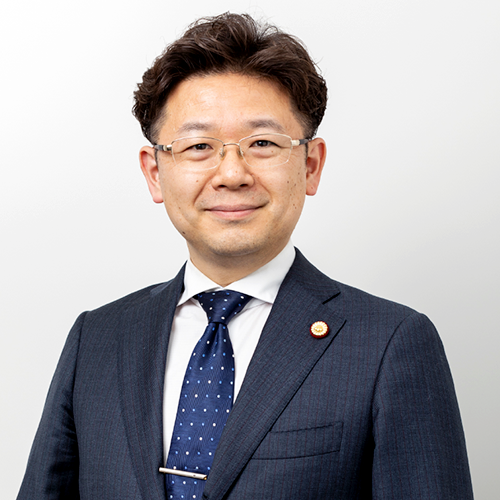2020.03.31
Current Status of Remedies for Expired Request for Substantive Examination
PATENT
Current Status of Remedies for Expired Request for Substantive Examination
1. Introduction
It is necessary for a patent applicant who wants to acquire a patent to file a request for a substantive examination within 3 years from the date of filing an application. The application in which the request for a substantive examination is not filed within 3 years from the date of filing the application shall be deemed to be withdrawn.
In accordance with the revision of the Patent Act in the year 2014, the remedies for the expired request for the substantive examination have been introduced. The documents demanding the remedies for the expired request have been filed in 95 patent applications since this revision.]
In this article, the current status of the remedies for the expired request for the substantive examination shall be analyzed.
2. Requirements to be remedied
In the event that there is any "Good and Sufficient Reason" for the expired request for the substantive examination, an applicant may request for the substantive examination within 2 months after the reason has ceased to exist and within 1 year after the expiration date of the request for the substantive examination (Patent Act Article 48-3, Regulations under the Patent Act Article 31-2). For your added information, the "Good and Sufficient Reason" corresponds to the "Due Care" standard of Article 12 of the Patent Law Treaty (PLT).
Whether to be a "Good and Sufficient Reason" or not shall be determined under the following viewpoints:
Events that caused the expiration of the time limit;
Measures taken by the applicant, etc. to carry out the procedure; and
Parties who should take measures.
If the event that caused the expiration of the period is predictable (for example, any projected power outage, any premeditated hospitalization of the attorney, and so on), it is not generally determined to be the "Good and Sufficient Reason." Namely, no remedies are applicable.
If the event that caused the expiration of the period is not said to be predictable, it is determined that whether measures taken by the applicant, etc. to carry out the procedure are appropriate.
Measures to be determined are both measures taken by the applicant, etc. prior to the occurrence of such event and the same following the occurrence thereof. Whether such measures are appropriate is examined from the viewpoint of the parties who should take the measures. For example, the presence or absence of an attorney, the management system of the applicant and the attorney, instructions to the assistant and the like are examined.
The Japanese Patent Office has shown guidelines on the provisions of these remedies, of which URL is shown below.
https://www.jpo.go.jp/system/laws/rule/guideline/document/kyusai_method/h28guideline_e.pdf
3. Current status of the remedies
3-1. Approval ratio
The documents demanding the remedies for the expired request have been filed so far in 95 patent applications, in which the decisions of whether to approve or reject the remedies have been made in 88 cases (No decisions have been made on the remaining 7 cases).
Remedies have been approved in 12 cases of all 88 cases and procedures have been rejected (or determined to be rejected) in 76 cases (Fig. 1). The percentage of the cases in which the remedies have been approved is as low as 14%.
The applications have been filed by Japanese applicants in 70 cases of all 88 cases and foreign residents have filed the applications in the remaining 18 cases (Fig. 2). The ratio (20%) of foreigner's applications of which the remedies have been filed corresponded to the one (18% in the year 2017) of foreigner's applications in all of the patent applications filed in Japan.
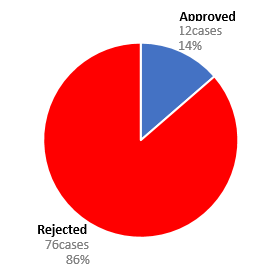 |
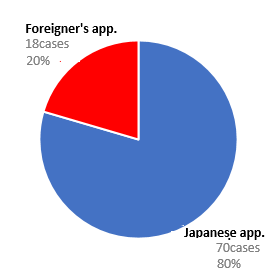 |
|
| Fig. 1: The ratio of approval and rejection (in all cases) | Fig. 2: The ratio of Japanese applicants and foreign applicants (in all cases) |
In 18 cases of the applications filed by foreign residents, the remedies have been approved in 3 cases and rejected in 15 cases (Fig. 3). The percentage of the cases in which the remedies have been approved is 17% in the applications filed by foreign residents.
Meanwhile, in 70 cases of the applications filed by Japanese applicants, the remedies have been approved in 9 cases and rejected in 61 cases. The percentage of the case in which the remedies have been approved is 13%. The ratio of which the remedies have been approved in the applications filed by foreign residents is slightly higher than the applications filed by Japanese applicants. However, since the total number of the cases is small, it cannot be asserted that the remedies tend to be approved more easily in the applications filed by foreign residents.
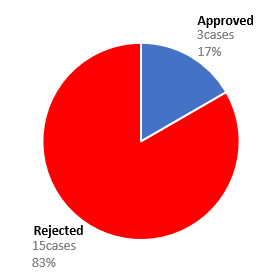 |
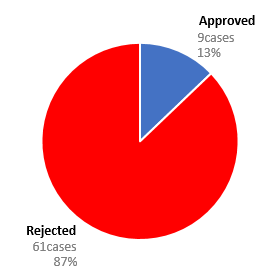 |
|
| Fig. 3: The ratio of approval and rejection (applications filed by foreign residents) | Fig. 4: The ratio of approval and rejection (applications filed by Japanese applicants) |
3-2. Reasons claimed
Reasons of the remedies claimed in the procedures shall be analyzed. The guideline of the Japanese Patent Office shows 3 examples of the events (natural disasters, system errors and human errors) that led to the expiration of the period. The table below shows the events claimed by applicants in 88 cases in which whether the remedies should be approved or rejected has been determined. In some cases, documents provided by the applicant and determination given by the Patent Office may not be disclosed. Those cases are classified as "unknown".
| applicant | matters | approval | rejection |
| foreign | Natural disasters | 0 | 0 |
| System errors | 0 | 5 | |
| Human errors | 0 | 9 | |
| unknown | 3 | 1 | |
| Japan | Natural disasters | 0 | 2 |
| System errors | 1 | 7 | |
| Human errors | 1 | 48 | |
| unknown | 7 | 4 |
Although it is worrisome that what causing event was claimed in the cases in which the remedies have been approved, most parts are unfortunately not disclosed. Regarding both a case in which "system error" has been claimed and another case in which "human error" has been claimed, after the rejection of the procedure was once determined, the determination has been overturned in subsequent procedures and the remedies have been finally approved. It is unknown how the determination was overturned.
In two cases that "natural disaster" was claimed (applicant : Japan), the applicant claimed that the causing event was the damage suffered by Kumamoto Earthquakes occurred in April, 2016. However, the Patent Office rejected the procedure for the reasons that the earthquakes occurred two years before the expiration of the period and it was possible to take the procedure since joint applicants did not suffer any damage from the earthquakes.
The causing events claimed as "human error" are for example as follows: misunderstanding of the period; erroneous input to a management system; alarm oversight due to an urgent business trip; insufficient takeover due to sudden retirement of a person in charge; and misunderstanding of the instruction by an assistant.
Sudden illness/hospitalization suffered by an applicant or an attorney shall be also classified in "human error" (same as the guideline of the Patent Office noted above). Sudden illness is an unpredictable event and should be remedied. However, the Patent Office has determined that the boss/colleague of the person in charge who suddenly took ill did not take the appropriate measures so that the remedies were not approved.
The causing events claimed as "system error" are for example as follows: non-delivery of email; personal computer failure (virus infection and breakdown); and network connection disorder.
The causes of the non-delivered email were claimed to be mail server failure, automatic distribution to spam mail, personal computer failure, etc. The Patent Office determined not to approve remedies since despite that it is possible to contact by telephone or any other means if any response to the sent email cannot be reached, such appropriate measures have not been taken.
Regarding failure of personal computers and network connections, the Patent Office determined not to approve the remedies since despite that it is possible to take other measures (for example, a written request for a substantive examination), such appropriate measures have not been taken.
4. Conclusion
As can be seen from the analysis noted above, the remedies of expiration of the period are difficult to be approved in Japan. At first, a management system (communication procedures, double checks, etc.) should be established in order not to expire the period. Specific attention should be paid to the non-delivery of email. Although email is a widely used communication method, non-delivered email accidents can easily occur due to troubles with the mail server or PC. If reception by the other party cannot be confirmed, confirmation by telephone, etc. should be carried out.
Additionally, leaving evidence should be taken into consideration in order to enable appropriate claims just in case of any accident. Evidence proves that appropriate measures have been taken, and includes documents describing the management system and operation procedures, documents related to education and instructions for assistants and records of communications. In the event that it is claimed to have made a voice call, the communication record kept in the telephone company may be required in addition to a declaration.
